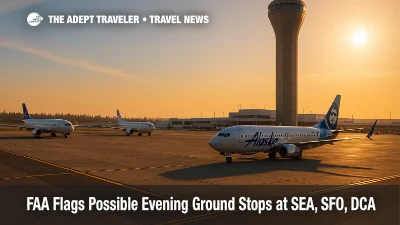FAA Flags Possible Evening Ground Stops at SEA, SFO, DCA

The Federal Aviation Administration's late-day operations plan warns that Seattle-Tacoma International, San Francisco International, and Ronald Reagan Washington National could face ground stops or ground-delay programs through the evening, compounding weather-related slow-downs already under way at major Florida and Texas hubs. Travelers heading through any of these airports should monitor flight-status feeds and be prepared for rolling gate holds.
Key Points
- Why it matters: Three coast-to-coast hubs now risk cascading delays.
- Travel impact: Missed connections likely as airlines scramble to re-bank flights.
- What's next: FAA will update its plan after 8 p.m. Eastern; further ground stops could expand.
- Carriers may waive change fees once initiatives become official.
- Rebook early afternoon departures to dodge the traffic-management window.
Snapshot
Seattle-Tacoma International Airport (SEA), San Francisco International Airport (SFO), and Ronald Reagan Washington National Airport (DCA) are flagged for possible evening ground-traffic initiatives beginning 5:30 p.m. Eastern. Simultaneously, the FAA Daily Air Traffic Report continues to list thunderstorms over Miami International (MIA), Fort Lauderdale-Hollywood International (FLL), Orlando International (MCO), Dallas-Fort Worth International (DFW), Dallas Love Field (DAL), George Bush Intercontinental (IAH), and William P. Hobby (HOU), where arrival and departure delays already exceed 45 minutes.
Background
Summer afternoons regularly force the FAA to space arrivals when thunderstorms build along busy approach corridors. On Monday morning the agency issued brief ground stops for the Houston pair of airports, lifting them by midday yet keeping a traffic-management program in place. Similar convective bands have plagued Florida since sunrise, prompting airlines to warn travelers of rolling holds and sporadic cancellations. The National Airspace System Status board is the primary coordination tool; once an airport slips from "possible" to "active" status, carriers must file for revised wheels-up times, creating ripple effects across their route maps.
Latest Developments
West Coast and Mid-Atlantic on Alert
The 7 p.m. FAA planning webinar inserted SEA, SFO, and DCA into its "possible ground-stop" column, citing deteriorating low-cloud ceilings in Seattle, gusty crosswinds in San Francisco, and pop-up thunderstorms clipping Washington's Potomac approach. If a formal ground stop is declared, inbound aircraft still at the gate elsewhere will be held, while those already airborne could be forced into airborne-delay stacks or diversions. Alaska, United, American, and Delta all rely on these airports for trans-continental connections, so knock-on delays could spread quickly across their evening banks.
Storm Systems Keep Florida and Texas Busy
The Daily Air Traffic Report remains pessimistic for South-Florida and North-Texas operations through at least 10 p.m. Eastern. Fast-moving cells continue to trigger flow-rate reductions at MIA, FLL, and MCO, while remnants of the same frontal boundary hover over DFW and DAL. Houston's twin airports escaped the morning ground stop yet still carry a 45-minute average departure delay for late-day push waves. Travelers can follow our earlier ground-stop coverage for tips on reticketing and overnight hotel options. (See our July 29 story on Florida and Texas ground stops.)
Analysis
Air-traffic planners face a complex handoff tonight. Any decision to issue concurrent ground stops at SEA, SFO, and DCA will strain east-west corridor capacity just as thunderstorms bottle-neck flow through Florida and Texas. Airlines will likely swap larger aircraft onto constrained routes, delay outbound crew assignments, and reroute cargo to secondary hubs. Passengers booked on tight 40-minute connections are most at risk; booking engines seldom pad minimum-connection times for irregular-operations days, so even a 15-minute gate hold can cause a misconnect cascade. The FAA's real-time metering strategy generally keeps airborne delay lower than the pre-2011 era, but it also shifts burden onto travelers stuck ground-side. Each additional hub tagged "possible" pushes dispatchers into triage mode, choosing between ground holds, fuel stops, or cancellations. Expect airlines to roll out weather waivers once any of tonight's "possible" initiatives turn into formal programs.
Final Thoughts
With weather pinning down Florida and Texas and the FAA now eyeing Seattle, San Francisco, and Washington National, tonight's network-wide reliability rests on whether those "possible" tags become active ground stops. Keep mobile notifications on, and, if you have flexibility, shift flights earlier tomorrow morning once the airspace resets after the FAA ground stops window.
